1994 CHEVROLET S10 four wheel drive
[x] Cancel search: four wheel drivePage 48 of 340

Downloaded from www.Manualslib.com manuals search engine ...
.
Four-wheel Drive ......................................... 2-27
Manual Transfer Case
.................................... 2-27
Electronic Transfer Case
.................................. 2-29
Windows
................................................ 2-31
Horn
.................................................... 2-33
TiltWheel
............................................... 2-33
Turn SignaYMultifunction Lever
.............................. 2-34
Turn Signal and Lane Change Indicator
...................... 2-34
Headlight High-Low Beam
............................... 2-36
Windshield Wipers
...................................... 2-36
Windshield Washer
...................................... 2-37
Cruise Control
.......................................... 2-39
Lights
................................................... 2-45
Mirrors
.................................................. 2-48
Accessory Power Outlets
.................................... 2-51
Cigarette LightedAshtray ................................... 2-52
Storage Compartments ...................................... 2-53
Instrument Cluster
......................................... 2-55
Wamrng Lights, Gages and Indicators
....................... 2-58
Center High Mounted Stop Lamp (CHMSL) Feed Wire
............ 2-67
Trailer Wiring Harness
...................................... 2-68
2-2
Page 65 of 340
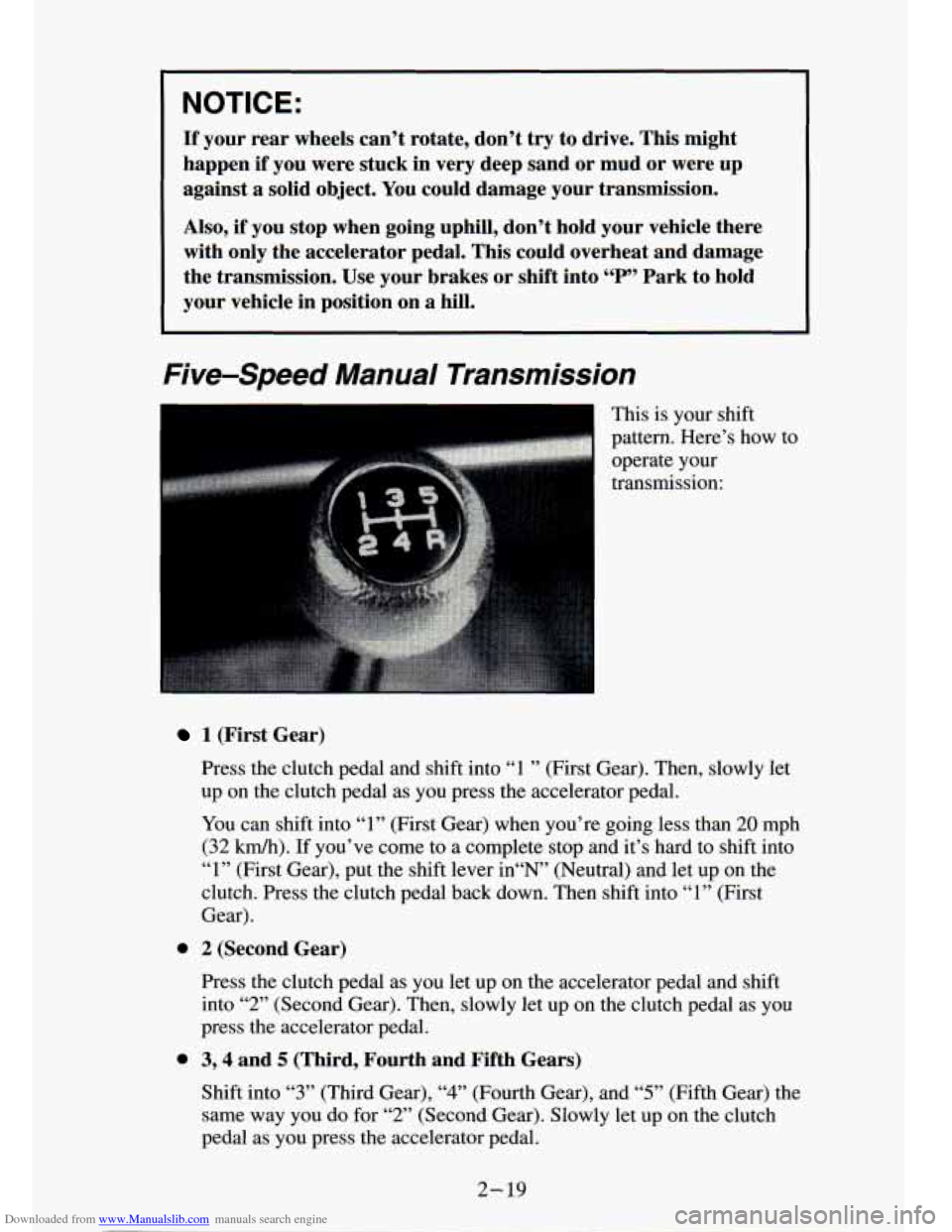
Downloaded from www.Manualslib.com manuals search engine NOTICE:
If your rear wheels can’t rotate, don’t try to drive. This might
happen
if you were stuck in very deep sand or mud or were up
against a solid object. You could damage your transmission.
Also,
if you stop when going uphill, don’t hold your vehicle there
with only the accelerator pedal. This could overheat and damage
the transmission. Use your brakes or shift into
“P” Park to hold
your vehicle in position on
a hill.
Five-Speed Manual Transmission
This is your shift
pattern. Here’s how to
operate your
transmission:
1 (First Gear)
Press the clutch pedal and shift into
“1 ” (First Gear). Then, slowly let
up on the clutch pedal as you press the accelerator pedal.
You can shift into
“1” (First Gear) when you’re going less than 20 mph
(32 km/h). If you’ve come to a complete stop and it’s hard to shift into
“1” (First Gear), put the shift lever in“N” (Neut\
ral) and let up
on the
clutch. Press the clutch pedal back down. Then shift into
“1” (First
Gear).
0 2 (Second Gear)
Press the clutch pedal as you let up
on the accelerator pedal and shift
into
“2” (Second Gear). Then, slowly let up on the clutch pedal as y\
ou
press the accelerator pedal.
0 3’4 and 5 (Third, Fourth and Fifth Gears)
Shift into
“3” (Third Gear), “4” (Fourth Gear), and “5” (Fifth Gear) the
same way
you do for “2” (Second Gear). Slowly let up on the clutch
pedal as
you press the accelerator pedal.
2-19
Page 67 of 340

Downloaded from www.Manualslib.com manuals search engine Four-wheel Drive Vehicles Only: If your vehicle has four-wheel drive
and is equipped with a manual transmission, disregard the shift light when
the transfer case is in
4LO.
Locking Rear Axle
If you have this feature, your rear axle can give you additio\
nal traction on
snow, mud, ice, sand
or gravel. It works like a standard axle most of the
time, but when one of the rear wheels has no traction and the other does, the
locking feature will allow the. wheel with traction to move the vehicle.
Parking Brake
To Set the Parking Brake:
To Release the Parking Brake:
Hold the regular brake
pedal down with your
right foot. Push down
the parking brake
pedal with your left
foot. If the ignition is
on, the brake' system
warning light will
come
on.
Hold the regular brake
pedal down. Pull the
brake release lever.
I
2-21
Page 69 of 340
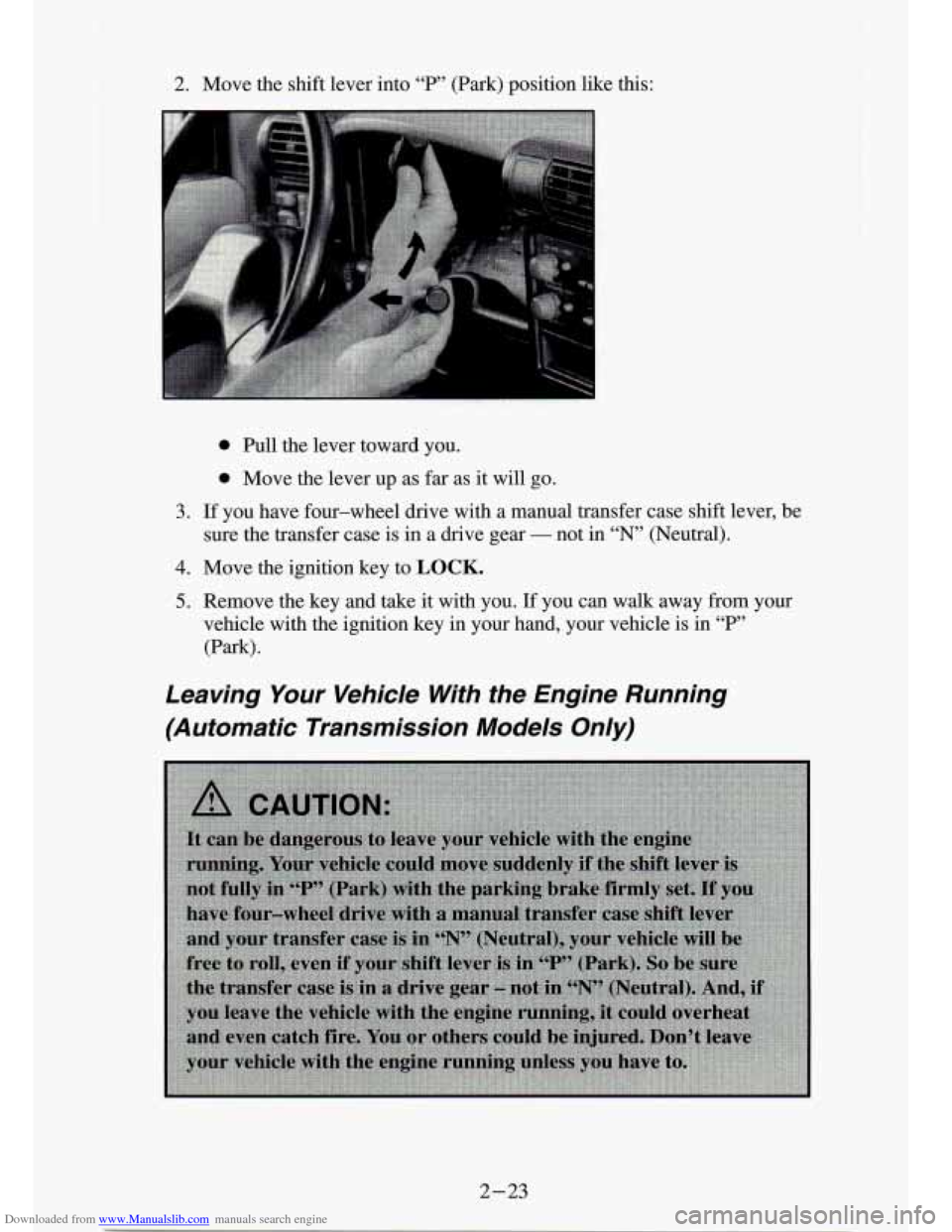
Downloaded from www.Manualslib.com manuals search engine 2. Move the shift lever into “P” (Park) position like this:
0 Bull the lever toward you.
0 Move the lever up as far as it will go.
3. If you have four-wheel drive with a manual transfer case shift lever, \
be
4. Move the ignition key to LOCK.
5. Remove the key and take it with you. If you can walk away from your
sure
the transfer case is in a drive gear
- not in “N’ (Neutral).
vehicle with the ignition key in your hand, your vehicle is i\
n
“P”
(Park).
Leaving Your Vehicle Wth the Engine Running
(Automatic Transmission Models Only)
2-23
Page 70 of 340
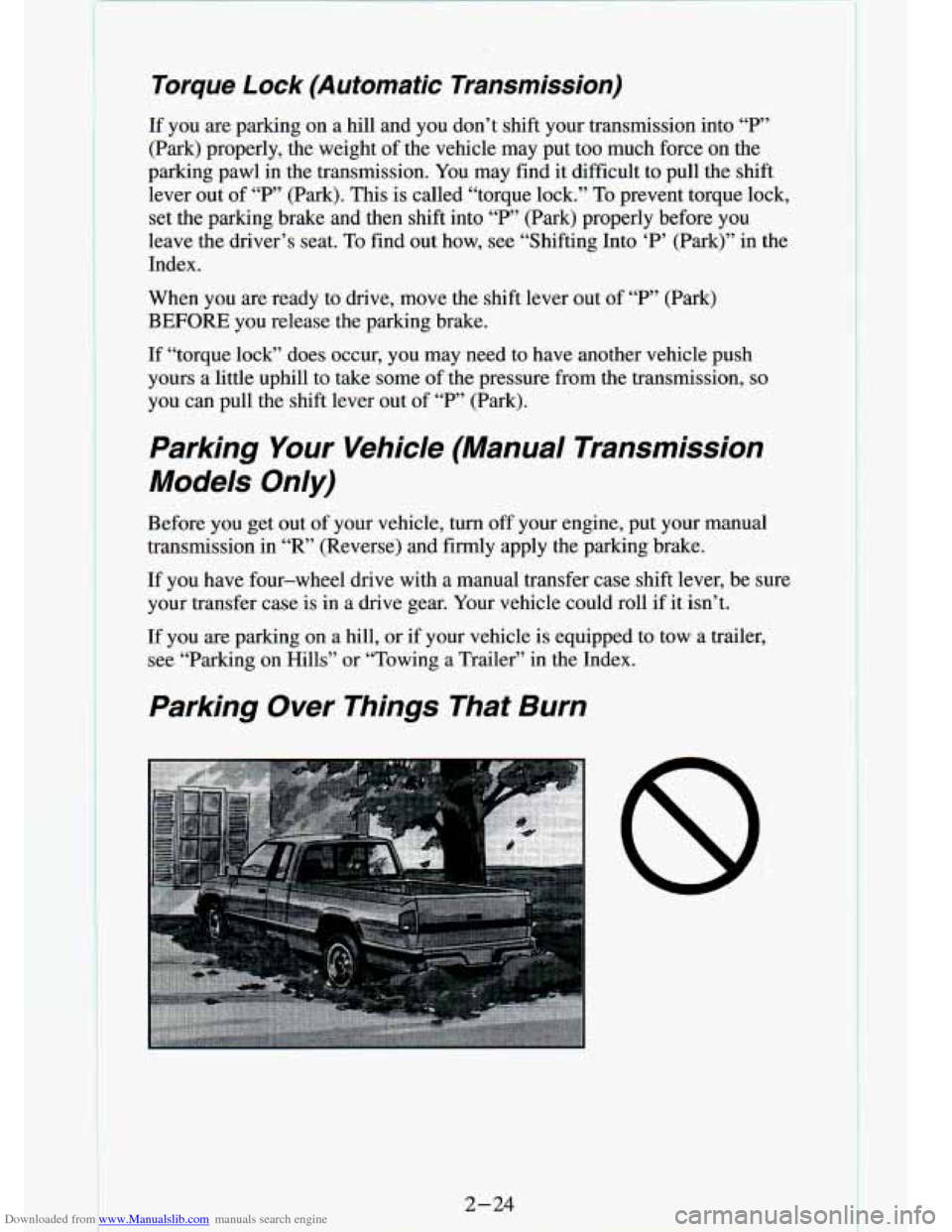
Downloaded from www.Manualslib.com manuals search engine Torque Lock (Automatic Transmission)
If you are parking on a hill and you don’t shift your transmission into “P’
(Park) properly, the weight of the vehicle may put too much force on the
parking pawl in the transmission. You may find it difficult to pull the shift
lever out of
“P” (Park). This is called “torque lock.” To prevent torque lock,
set the parking brake and
then shift into “P” (Park) properly before you
leave the driver’s seat.
To find out how, see “Shifting Into ‘P’ (Park)” in the
Index.
When you are ready to drive, move the shift lever out of
“P” (Park)
BEFORE you release the parking brake.
If “torque lock” does occur, you may need to have another vehicle push
yours a little uphill
to take some of the pressure from the transmission, so
you can pull the shift lever out of “P’ (Park).
Parking Your Vehicle (Manual Transmission
Models Only)
Before you get out of your vehicle, turn off your engine, put your manual
transmission in
“R’ (Reverse) and firmly apply the parking brake.
lr you have four-wheel drive with a manual transfer case shift lever, be sure
your transfer case is
in a drive gear. Your vehicle could roll if it isn’t.
If you are parking on
a hill, or if your vehicle is equipped to tow a trailer,
see “Parking on Hills” or “Towing
a Trailer” in the Index.
Parking Over Things That Burn
8
2- 24
Page 72 of 340
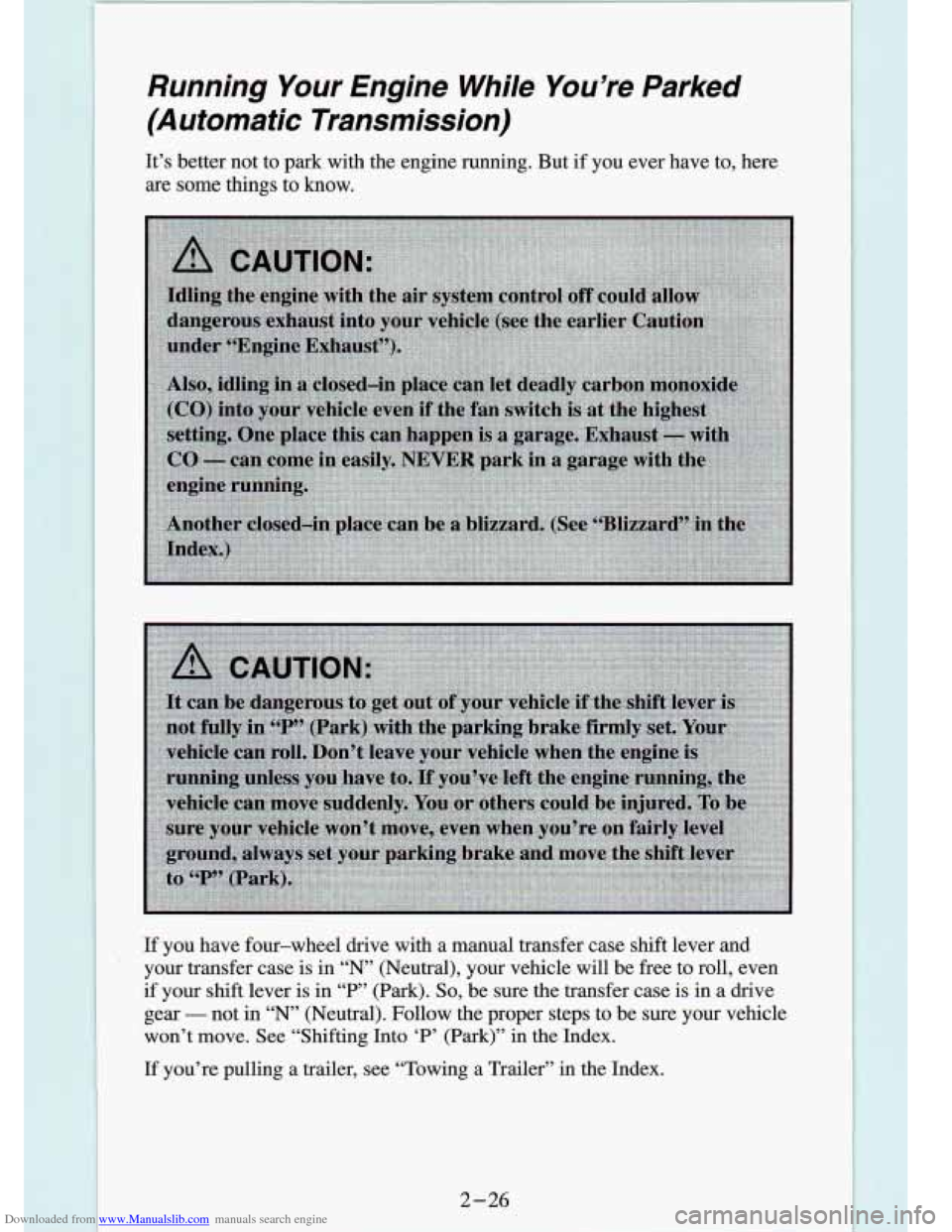
Downloaded from www.Manualslib.com manuals search engine Running Your Engine While You’re Parked
(Automatic Transmission)
It’s better not to park with the engine running. But if you ever have to, here
are some things
to know.
If you have four-wheel drive with a manual transfer case shift lever and
your transfer case is in “N” (Neutral), your vehicle wi\
ll be free to roll, even
if your shift lever is in “P’ (Park). So, be sure the transfer case is in a drive
gear
- not in “N’ (Neutral). Follow the proper steps to be sure your vehicle
won’t move. See
“Shifting Into ‘P’ (Park)” in the Index.
If you’re pulling a trailer, see “Towing a Trailer’’ in\
the Index.
2-26
Page 73 of 340
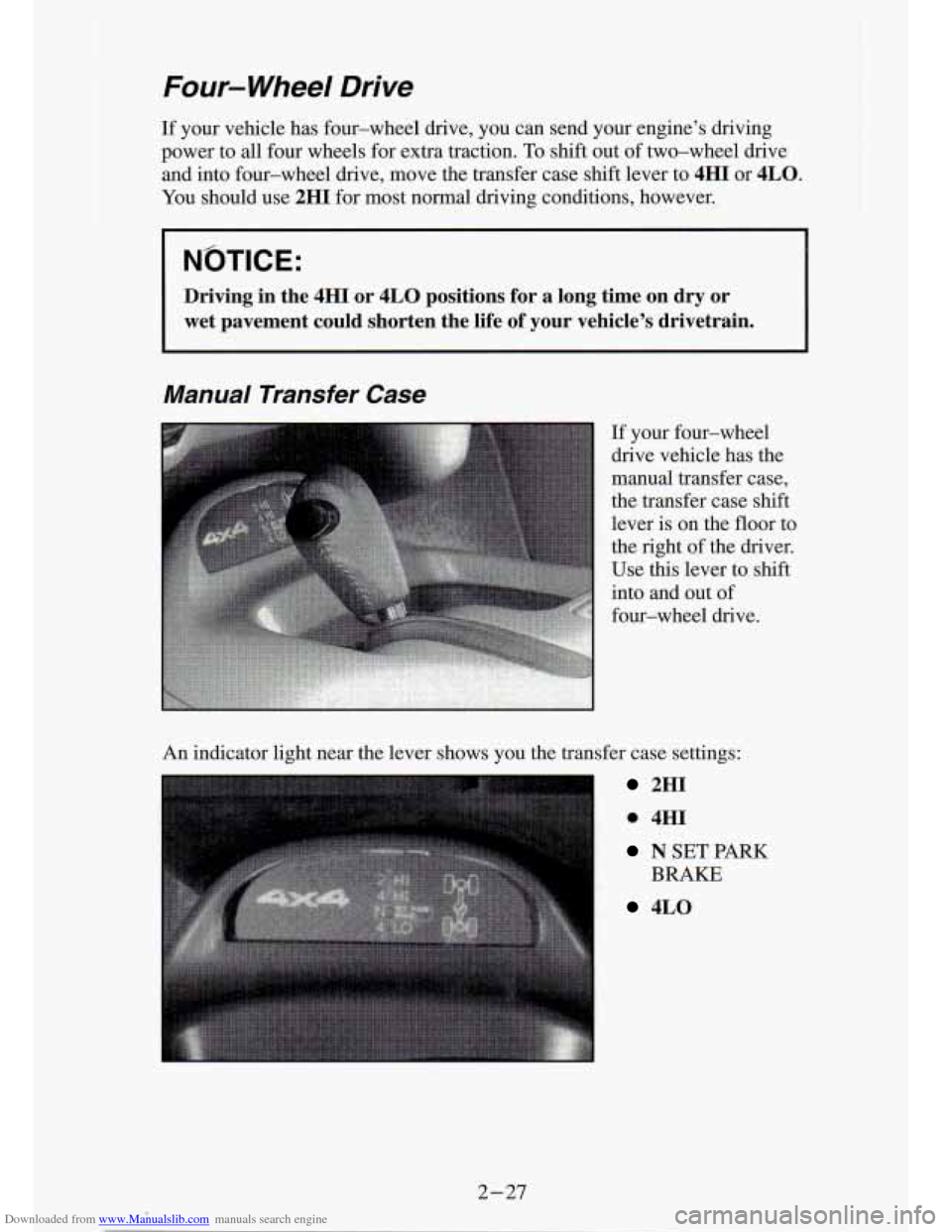
Downloaded from www.Manualslib.com manuals search engine Four- Wheel Drive
If your vehicle has four-wheel drive, you can send your engine’\
s driving
power to all four wheels for extra traction.
To shift out of two-wheel drive
and into four-wheel drive, move the transfer case shift lever to
4HI or 4LO.
You should use 2HI for most normal driving conditions, however.,
NOTICE:
Driving in the 4HI or 4LO positions for a long time on dry or
wet pavement could shorten the life of your vehicle’s drivet\
rain.
Manual Transfer Case
An indicator light near the lever shows you the transfer
If your four-wheel
drive vehicle has the
manual transfer case,
the transfer case shift
lever is
on the floor to
the right of the driver.
Use this lever to shift
into and out of
four-wheel drive.
- case settings:
2HI
An indicator light near the lever shows you the transfer case settings:
2HI
@ 4HI
NSETPARK
BRAKE
4LO
@ 4HI
NSETPARK
BRAKE
4LO
2-27
Page 74 of 340
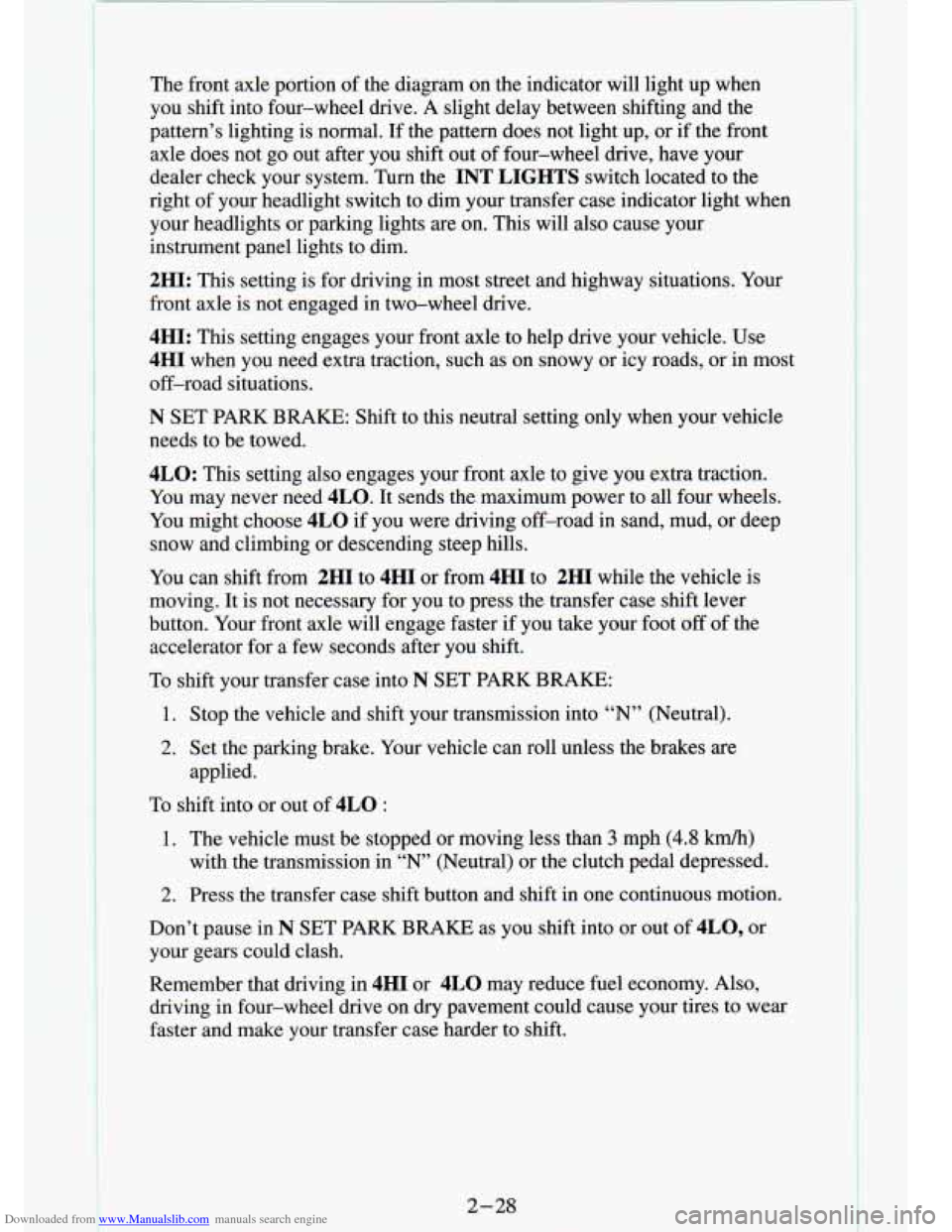
Downloaded from www.Manualslib.com manuals search engine ..
The front axle portion of the diagram on the indicator will light up when
you shift into four-wheel drive. A slight delay between shifting an\
d the
pattern’s lighting is normal. If the pattern does not light up, or if the front
axle does not go out after you shift out of four-wheel drive, have your
dealer check your system. Turn the
INT LIGHTS switch located to the
right of your headlight switch to dim your transfer case indicator light\
when
your headlights or parking lights are on. This will also cause\
your
instrument panel lights to dim.
2HI: This setting is for driving in most street and highway situations. Your
front axle is not engaged in two-wheel drive.
4HI: This setting engages your front axle to help drive your vehicl\
e. Use
4HI when you need extra traction, such as on snowy or icy roads, \
or in most
off-road situations.
N SET PARK BRAKE: Shift to this neutral setting only when your vehicle
needs to be towed.
4LO: This setting also engages your front axle to give you extra traction.
You may never need
4LO. It sends the maximum power to all four wheels.
You might choose
4LO if you were driving off-road in sand, mud, or deep
snow and climbing or descending steep hills.
You can shift from
2HI to 4HI or from 4HI to 2HI while the vehicle is
moving. It is not necessary for you to press the transfer case shift lever
button. Your front axle will engage faster
if you take your foot off of the
accelerator for a few seconds after you shift.
To shift your transfer case into N SET PARK BRAKE:
1. Stop the vehicle and shift your transmission into “N” (Neutral).
2. Set the parking brake. Your vehicle can roll unless the brakes are
applied.
To shift into or out of 4LO :
1. The vehicle must be stopped or moving less than 3 mph (4.8 Wh)
with the transmission in “N’ (Neutral) or the clutch pedal depressed.
2. Press the transfer case shift button and shift in one continuous motion.
Don’t pause in
N SET PARK BRAKE as you shift into or out of 4L0, or
your gears could clash.
Remember that driving in
4HI or 4LO may reduce fuel economy. Also,
driving in four-wheel drive on dry pavement could cause your t\
ires to wear
faster and make your transfer case harder to shift.
2-28
I